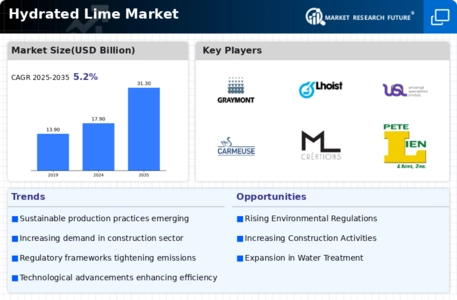Market Trends
Key Emerging Trends in the Hydrated Lime Market
The hydrated lime market has been witnessing notable trends in recent years, influenced by various factors such as industrialization, environmental regulations, and advancements in manufacturing processes. One significant trend in the market is the growing demand for hydrated lime in the construction industry. Hydrated lime is widely used in construction applications such as mortar and plaster due to its ability to improve workability, durability, and adhesive properties of building materials. With increasing construction activities worldwide, particularly in emerging economies, the demand for hydrated lime is expected to continue rising, driving market growth in the construction sector.
Moreover, sustainability has emerged as a key trend shaping the hydrated lime market. As environmental concerns gain prominence, there is a growing emphasis on sustainable building materials and construction practices. Hydrated lime offers several environmental benefits, including its natural abundance, low energy consumption during production, and ability to improve the durability and longevity of concrete structures. Additionally, hydrated lime can be used in soil stabilization and environmental remediation applications, contributing to sustainable infrastructure development and environmental protection efforts. Manufacturers are increasingly focusing on eco-friendly production processes and promoting the use of hydrated lime as a sustainable solution in construction and environmental projects.
Furthermore, technological advancements have led to innovations in the production and application of hydrated lime, driving market growth and diversification. Advanced manufacturing techniques, such as hydration plants with high efficiency and automation, have enabled manufacturers to produce hydrated lime more cost-effectively and with higher quality. Moreover, advancements in lime-based products, such as hydrated lime-based mortars, plasters, and coatings, offer improved performance characteristics and versatility for various construction and industrial applications. These technological advancements are driving innovation and differentiation in the hydrated lime market, catering to the evolving needs of industries such as construction, mining, and wastewater treatment.
Additionally, the COVID-19 pandemic has had a significant impact on the hydrated lime market, influencing consumer behavior, supply chain dynamics, and market trends. With lockdowns and restrictions disrupting economic activities and construction projects, the demand for hydrated lime faced challenges such as reduced consumption and production disruptions. However, as economies gradually reopen and infrastructure investments resume, the demand for hydrated lime is expected to rebound, driving market recovery and growth in the post-pandemic period. Moreover, the pandemic has accelerated trends such as digitalization and remote monitoring in the lime industry, as manufacturers seek to improve efficiency, resilience, and adaptability in response to changing market conditions.
On the other hand, the hydrated lime market is facing challenges such as fluctuating raw material prices, regulatory uncertainties, and competition from alternative materials. Fluctuations in the prices of raw materials such as limestone and quicklime can impact production costs and pricing strategies for hydrated lime manufacturers, influencing market trends and competitiveness. Moreover, regulatory uncertainties related to environmental regulations and safety standards can pose challenges for manufacturers in terms of compliance and market access. Additionally, competition from alternative materials such as Portland cement and synthetic additives may limit the growth potential of the hydrated lime market, particularly in certain applications and regions.


 Source: Secondary Research, Primary Research, Market Research Future Database and Analyst Review
Source: Secondary Research, Primary Research, Market Research Future Database and Analyst Review








Leave a Comment